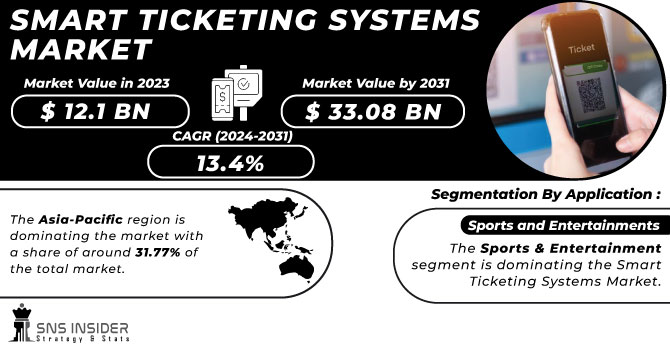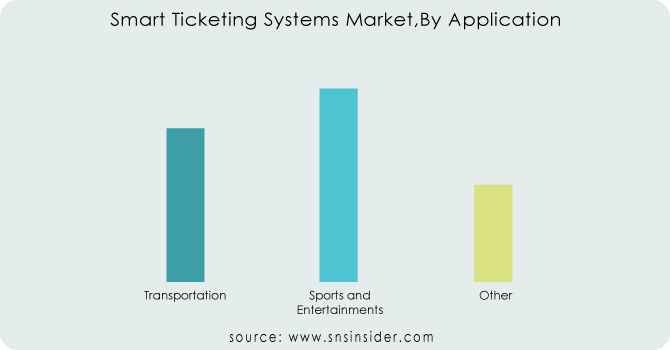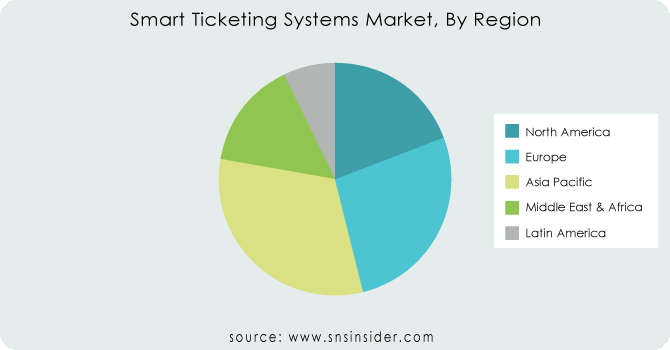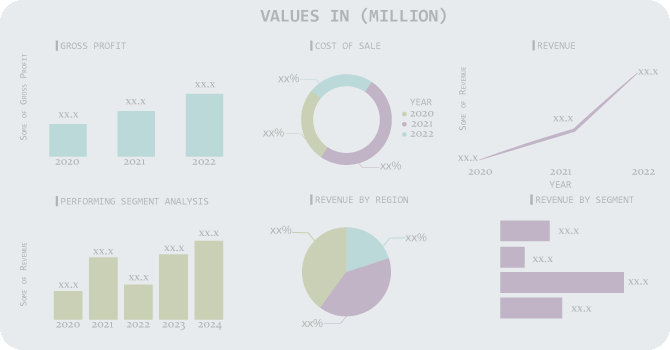The Smart Ticketing Systems Market size was valued at USD 12.1 Billion in 2023 and is now anticipated to grow to USD 33.08 Billion by 2031, displaying a compound annual growth rate (CAGR) of 13.4% during the forecast Period 2024-2031.
The Smart Ticketing Systems Market is growing at a steady rate with a variety of factors into picture. Key factor for the growth is the machines offer much faster & convenient alternative then traditional booths at the same time reducing time.

Get More Information on Smart Ticketing Systems Market - Request Sample Report
The ticket machine offers 24/7 availability for usage at any time. Also, the flexibility machines offer in payment mode like cash or cashless (card, contactless) is helping in the growth of the market. Further, technology advancements like interface touch screen & multiple languages cater to wide range of consumers. Also, the integration with smart ticketing systems for real time fare calculation, seamless ticket purchase is propelling the market. At the same time increasing government initiatives in public transportation is making a driving factor in market growth. Moreover, the rising awareness towards sustainability has reduced paper wastage by digitizing ticketing is further helping in market growth.
Market Dynamics
Drivers
Increasing effectiveness of ticket vending machines is helping in the market growth.
Reduced labor costs and operation times is driving the market towards growth.
Employing labor costs contribute to considerable share of costs to service providers. During service operation, the human error possibility is high which could lead to higher operational time while automatic machines operate error-free and is less time taking. At the same time, it reduces human resource need at each step of operation thus cutting cost.
Restraints
High cost of Installation may be a restraining factor in the market growth.
Operational network failure is creating a restraint in the growth of market.
Opportunities
Reduced cost of operation & improved security is creating growth opportunities for the market.
Increasing popularity of digital payment in Smart Ticketing Systems is creating growth opportunities.
Manufacturers are focusing more towards machine innovation like RFID, NFC & Zigbee technology in order to gain competitive advantage. These technologies provide proactive maintenance & remote monitoring to pinpoint any problems associated with automated ticket machines. This advancement is creating more convenience and drawing more customers. At the same time lesser chance of operation.
Challenges
Integrating Smart Ticketing Systems with existing old systems can be complicating leading to challenges.
Constant maintenance requirements to ensure proper functionality is creating challenge in the market growth
The Russia-Ukraine war has a huge impact on Smart Ticketing Systems Market. With disruptions in the global supply chain with Russia as an exporter of raw materials used in machine like screens, printers lead to shortage and price hikes. The price hike can lower down the profit margins for manufacturers. The war has increased the transportation costs with imports as-well-as exports of finished goods & intermediate goods further complicating matters. The war is also affecting the demand with economic uncertainties that are affected by the war especially Europe because of its proximity. The war has put a halt in the upgradation in infrastructure also including public transportation system putting a dip in demand for automatic ticket machines. But on the other side, governments may encourage domestic manufacturer amidst of war to reduce reliance over disrupted global supply chain and may prioritize in maintaining & upgrading existing machines benefitting service & maintenance solutions.
The economic slowdown war has a huge impact on Smart Ticketing Systems Market. The slowdown has impacted growth and production with tight government as-well-as business budgets causing a dip in demand for public transport investment. Transport authorities may delay in investing new ticketing systems having a direct impact in demand for Smart Ticketing Systems. The slowdown is also affecting supply chains causing longer lead time and delaying production schedules thus inflating the cost for manufacturing. Also, the slowdown is causing job loss impacting availability of skilled labor required for fabrication of ticket machines. On the other side, the slowdown can prioritize commuters to use public transport instead of private ones in order to save money. Installing Smart Ticketing Systems during the slowdown can also reduce labor cost by elimination of staff booth and providing efficiency in ticket managing process. Also targeting sectors less affected by slowdown like train stations & Airports can help in stabilizing the market.
By Type
Cash Payment
Online Payment
By Application
Transportation
Sports and Entertainments
Other
The Sports & Entertainment segment is dominating the Smart Ticketing Systems Market. The dominance is because of increasing number of retail setups & multi-specialty hubs for entertainment & games is providing just-in-time ticketing thereby reducing time. Also, the integration of smart ticketing systems by use of IoT & AI is further making convenience for customers.

Need Customized Research on Smart Ticketing Systems Market - Enquiry Now
The Asia-Pacific region is dominating the market with a share of around 31.77% of the total market. The dominance is because of factors like rising passengers travelling via buses, growing railway traffic & renovation projects for airports and commercial buildings across the region. Also, various sectors are contributing towards dominance like movie theaters, commercial stores are growing along with emerging economies with heavy investments on infrastructure is driving the growth for the market in this region.
Europe is the fastest growing region due to presence of key manufacturers of interactive kiosks.

Regional Outlook
North America
US
Canada
Mexico
Europe
Eastern Europe
Poland
Romania
Hungary
Turkey
Rest of Eastern Europe
Western Europe
Germany
France
UK
Italy
Spain
Netherlands
Switzerland
Austria
Rest of Western Europe
Asia Pacific
China
India
Japan
South Korea
Vietnam
Singapore
Australia
Rest of Asia Pacific
Middle East & Africa
Middle East
UAE
Egypt
Saudi Arabia
Qatar
Rest of the Middle East
Africa
Nigeria
South Africa
Rest of Africa
Latin America
Brazil
Argentina
Colombia
Rest of Latin America
The major key players are Parkeon, Xerox Corporation, CPI Card Group Inc., Infineon Technologies AG, NXP Semiconductors, Scheidt & Bachmann GmbH, Gemalto NV, Cubic Corporation, Diebold Nixdorf Incorporated, SBB and others.
Xerox Corporation-Company Financial Analysis

In April 2024, Scheidt & Bachmann announced a partnership with a European transportation authority to implement multimodal ticketing machines across their network. This allows passengers to purchase tickets for buses, trains, and trams on a single platform, enhancing convenience for multi-modal commuters.
| Report Attributes | Details |
|---|---|
| Market Size in 2023 | US$ 12.1 Billion |
| Market Size by 2031 | US$ 33.08 Billion |
| CAGR | CAGR of 13.4% From 2024 to 2031 |
| Base Year | 2023 |
| Forecast Period | 2024-2031 |
| Historical Data | 2020-2022 |
| Report Scope & Coverage | Market Size, Segments Analysis, Competitive Landscape, Regional Analysis, DROC & SWOT Analysis, Forecast Outlook |
| Key Segments | • By Type (Cash Payment, Online Payment) • By Application (Transportation, Sports And Entertainments, Others) |
| Regional Analysis/Coverage | North America (US, Canada, Mexico), Europe (Eastern Europe [Poland, Romania, Hungary, Turkey, Rest of Eastern Europe] Western Europe] Germany, France, UK, Italy, Spain, Netherlands, Switzerland, Austria, Rest of Western Europe]), Asia Pacific (China, India, Japan, South Korea, Vietnam, Singapore, Australia, Rest of Asia Pacific), Middle East & Africa (Middle East [UAE, Egypt, Saudi Arabia, Qatar, Rest of Middle East], Africa [Nigeria, South Africa, Rest of Africa], Latin America (Brazil, Argentina, Colombia, Rest of Latin America) |
| Company Profiles | Parkeon, Xerox Corporation, CPI Card Group Inc., Infineon Technologies AG, NXP Semiconductors, Scheidt & Bachmann GmbH, Gemalto NV, Cubic Corporation, Diebold Nixdorf Incorporated, SBB |
| Key Drivers | • Increasing effectiveness of ticket vending machines is helping in the market growth. • Reduced labor costs and operation times is driving the market towards growth. |
| Restraints | • High cost of Installation may be a restraining factor in the market growth. • Operational network failure is creating a restraint in the growth of market. |
Ans: Parkeon, Xerox Corporation, CPI Card Group Inc., Infineon Technologies AG, NXP Semiconductors, Scheidt & Bachmann GmbH, Gemalto NV, Cubic Corporation, Diebold Nixdorf Incorporated, SBB, Thales Group, Kiosk Information Systems, AEP Ticketing Solutions, LecIP, Vix Technology, Wincor Nixdorf, St. Andrew’s Group, Micros Systems, Kaba Group, Zebra Technologies.
Ans: The Market is expected to grow at a CAGR of 13%.
Ans: Increasing effectiveness of ticket vending machines is helping in the market growth.
Ans: Operational network failure is creating a restraint in the growth of market.
Ans: Asia-Pacific is expected to hold the largest market share in the market during the forecast period.
Table of Contents
1. Introduction
1.1 Market Definition
1.2 Scope
1.3 Research Assumptions
2. Industry Flowchart
3. Research Methodology
4. Market Dynamics
4.1 Drivers
4.2 Restraints
4.3 Opportunities
4.4 Challenges
5. Impact Analysis
5.1 Impact Of Russia Ukraine Crisis
5.2 Impact of Economic Slowdown on Major Countries
5.2.1 Introduction
5.2.2 United States
5.2.3 Canada
5.2.4 Germany
5.2.5 France
5.2.6 UK
5.2.7 China
5.2.8 Japan
5.2.9 South Korea
5.2.10 India
6. Value Chain Analysis
7. Porter’s 5 Forces Model
8. Pest Analysis
9. Smart Ticketing Systems Market Segmentation, By Type
9.1 Introduction
9.2 Trend Analysis
9.3 Cash Payment
9.4 Online Payment
10. Smart Ticketing Systems Market Segmentation, By Application
10.1 Introduction
10.2 Trend Analysis
10.3 Transportation
10.4 Sports and Entertainments
10.5 Other
11. Regional Analysis
11.1 Introduction
11.2 North America
11.2.1 Trend Analysis
11.2.2 North America Smart Ticketing Systems Market by Country
11.2.3 North America Smart Ticketing Systems Market By Type
11.2.4 North America Smart Ticketing Systems Market By Application
11.2.5 USA
11.2.5.1 USA Smart Ticketing Systems Market By Type
11.2.5.2 USA Smart Ticketing Systems Market By Application
11.2.6 Canada
11.2.6.1 Canada Smart Ticketing Systems Market By Type
11.2.6.2 Canada Smart Ticketing Systems Market By Application
11.2.7 Mexico
11.2.7.1 Mexico Smart Ticketing Systems Market By Type
11.2.7.2 Mexico Smart Ticketing Systems Market By Application
11.3 Europe
11.3.1 Trend Analysis
11.3.2 Eastern Europe
11.3.2.1 Eastern Europe Smart Ticketing Systems Market by Country
11.3.2.2 Eastern Europe Smart Ticketing Systems Market By Type
11.3.2.3 Eastern Europe Smart Ticketing Systems Market By Application
11.3.2.4 Poland
11.3.2.4.1 Poland Smart Ticketing Systems Market By Type
11.3.2.4.2 Poland Smart Ticketing Systems Market By Application
11.3.2.5 Romania
11.3.2.5.1 Romania Smart Ticketing Systems Market By Type
11.3.2.5.2 Romania Smart Ticketing Systems Market By Application
11.3.2.6 Hungary
11.3.2.6.1 Hungary Smart Ticketing Systems Market By Type
11.3.2.6.2 Hungary Smart Ticketing Systems Market By Application
11.3.2.7 Turkey
11.3.2.7.1 Turkey Smart Ticketing Systems Market By Type
11.3.2.7.2 Turkey Smart Ticketing Systems Market By Application
11.3.2.8 Rest of Eastern Europe
11.3.2.8.1 Rest of Eastern Europe Smart Ticketing Systems Market By Type
11.3.2.8.2 Rest of Eastern Europe Smart Ticketing Systems Market By Application
11.3.3 Western Europe
11.3.3.1 Western Europe Smart Ticketing Systems Market by Country
11.3.3.2 Western Europe Smart Ticketing Systems Market By Type
11.3.3.3 Western Europe Smart Ticketing Systems Market By Application
11.3.3.4 Germany
11.3.3.4.1 Germany Smart Ticketing Systems Market By Type
11.3.3.4.2 Germany Smart Ticketing Systems Market By Application
11.3.3.5 France
11.3.3.5.1 France Smart Ticketing Systems Market By Type
11.3.3.5.2 France Smart Ticketing Systems Market By Application
11.3.3.6 UK
11.3.3.6.1 UK Smart Ticketing Systems Market By Type
11.3.3.6.2 UK Smart Ticketing Systems Market By Application
11.3.3.7 Italy
11.3.3.7.1 Italy Smart Ticketing Systems Market By Type
11.3.3.7.2 Italy Smart Ticketing Systems Market By Application
11.3.3.8 Spain
11.3.3.8.1 Spain Smart Ticketing Systems Market By Type
11.3.3.8.2 Spain Smart Ticketing Systems Market By Application
11.3.3.9 Netherlands
11.3.3.9.1 Netherlands Smart Ticketing Systems Market By Type
11.3.3.9.2 Netherlands Smart Ticketing Systems Market By Application
11.3.3.10 Switzerland
11.3.3.10.1 Switzerland Smart Ticketing Systems Market By Type
11.3.3.10.2 Switzerland Smart Ticketing Systems Market By Application
11.3.3.11 Austria
11.3.3.11.1 Austria Smart Ticketing Systems Market By Type
11.3.3.11.2 Austria Smart Ticketing Systems Market By Application
11.3.3.12 Rest of Western Europe
11.3.3.12.1 Rest of Western Europe Smart Ticketing Systems Market By Type
11.3.2.12.2 Rest of Western Europe Smart Ticketing Systems Market By Application
11.4 Asia-Pacific
11.4.1 Trend Analysis
11.4.2 Asia Pacific Smart Ticketing Systems Market by Country
11.4.3 Asia Pacific Smart Ticketing Systems Market By Type
11.4.4 Asia Pacific Smart Ticketing Systems Market By Application
11.4.5 China
11.4.5.1 China Smart Ticketing Systems Market By Type
11.4.5.2 China Smart Ticketing Systems Market By Application
11.4.6 India
11.4.6.1 India Smart Ticketing Systems Market By Type
11.4.6.2 India Smart Ticketing Systems Market By Application
11.4.7 Japan
11.4.7.1 Japan Smart Ticketing Systems Market By Type
11.4.7.2 Japan Smart Ticketing Systems Market By Application
11.4.8 South Korea
11.4.8.1 South Korea Smart Ticketing Systems Market By Type
11.4.8.2 South Korea Smart Ticketing Systems Market By Application
11.4.9 Vietnam
11.4.9.1 Vietnam Smart Ticketing Systems Market By Type
11.4.9.2 Vietnam Smart Ticketing Systems Market By Application
11.4.10 Singapore
11.4.10.1 Singapore Smart Ticketing Systems Market By Type
11.4.10.2 Singapore Smart Ticketing Systems Market By Application
11.4.11 Australia
11.4.11.1 Australia Smart Ticketing Systems Market By Type
11.4.11.2 Australia Smart Ticketing Systems Market By Application
11.4.12 Rest of Asia-Pacific
11.4.12.1 Rest of Asia-Pacific Smart Ticketing Systems Market By Type
11.4.12.2 Rest of Asia-Pacific Smart Ticketing Systems Market By Application
11.5 Middle East & Africa
11.5.1 Trend Analysis
11.5.2 Middle East
11.5.2.1 Middle East Smart Ticketing Systems Market by Country
11.5.2.2 Middle East Smart Ticketing Systems Market By Type
11.5.2.3 Middle East Smart Ticketing Systems Market By Application
11.5.2.4 UAE
11.5.2.4.1 UAE Smart Ticketing Systems Market By Type
11.5.2.4.2 UAE Smart Ticketing Systems Market By Application
11.5.2.5 Egypt
11.5.2.5.1 Egypt Smart Ticketing Systems Market By Type
11.5.2.5.2 Egypt Smart Ticketing Systems Market By Application
11.5.2.6 Saudi Arabia
11.5.2.6.1 Saudi Arabia Smart Ticketing Systems Market By Type
11.5.2.6.2 Saudi Arabia Smart Ticketing Systems Market By Application
11.5.2.7 Qatar
11.5.2.7.1 Qatar Smart Ticketing Systems Market By Type
11.5.2.7.2 Qatar Smart Ticketing Systems Market By Application
11.5.2.8 Rest of Middle East
11.5.2.8.1 Rest of Middle East Smart Ticketing Systems Market By Type
11.5.2.8.2 Rest of Middle East Smart Ticketing Systems Market By Application
11.5.3 Africa
11.5.3.1 Africa Smart Ticketing Systems Market by Country
11.5.3.2 Africa Smart Ticketing Systems Market By Type
11.5.3.3 Africa Smart Ticketing Systems Market By Application
11.5.2.4 Nigeria
11.5.2.4.1 Nigeria Smart Ticketing Systems Market By Type
11.5.2.4.2 Nigeria Smart Ticketing Systems Market By Application
11.5.2.5 South Africa
11.5.2.5.1 South Africa Smart Ticketing Systems Market By Type
11.5.2.5.2 South Africa Smart Ticketing Systems Market By Application
11.5.2.6 Rest of Africa
11.5.2.6.1 Rest of Africa Smart Ticketing Systems Market By Type
11.5.2.6.2 Rest of Africa Smart Ticketing Systems Market By Application
11.6 Latin America
11.6.1 Trend Analysis
11.6.2 Latin America Smart Ticketing Systems Market by Country
11.6.3 Latin America Smart Ticketing Systems Market By Type
11.6.4 Latin America Smart Ticketing Systems Market By Application
11.6.5 Brazil
11.6.5.1 Brazil Smart Ticketing Systems Market By Type
11.6.5.2 Brazil Smart Ticketing Systems Market By Application
11.6.6 Argentina
11.6.6.1 Argentina Smart Ticketing Systems Market By Type
11.6.6.2 Argentina Smart Ticketing Systems Market By Application
11.6.7 Colombia
11.6.7.1 Colombia Smart Ticketing Systems Market By Type
11.6.7.2 Colombia Smart Ticketing Systems Market By Application
11.6.8 Rest of Latin America
11.6.8.1 Rest of Latin America Smart Ticketing Systems Market By Type
11.6.8.2 Rest of Latin America Smart Ticketing Systems Market By Application
12. Company Profiles
12.1 Parkeon
12.1.1 Company Overview
12.1.2 Financial
12.1.3 Products/ Services Offered
12.1.4 SWOT Analysis
12.1.5 The SNS View
12.2 Xerox Corporation
12.2.1 Company Overview
12.2.2 Financial
12.2.3 Products/ Services Offered
12.2.4 SWOT Analysis
12.2.5 The SNS View
12.3 CPI Card Group Inc.
12.3.1 Company Overview
12.3.2 Financial
12.3.3 Products/ Services Offered
12.3.4 SWOT Analysis
12.3.5 The SNS View
12.4 Infineon Technologies AG
12.4.1 Company Overview
12.4.2 Financial
12.4.3 Products/ Services Offered
12.4.4 SWOT Analysis
12.4.5 The SNS View
12.5 NXP Semiconductors
12.5.1 Company Overview
12.5.2 Financial
12.5.3 Products/ Services Offered
12.5.4 SWOT Analysis
12.5.5 The SNS View
12.6 Scheidt & Bachmann GmbH
12.6.1 Company Overview
12.6.2 Financial
12.6.3 Products/ Services Offered
12.6.4 SWOT Analysis
12.6.5 The SNS View
12.7 Gemalto NV
12.7.1 Company Overview
12.7.2 Financial
12.7.3 Products/ Services Offered
12.7.4 SWOT Analysis
12.7.5 The SNS View
12.8 Cubic Corporation
12.8.1 Company Overview
12.8.2 Financial
12.8.3 Products/ Services Offered
12.8.4 SWOT Analysis
12.8.5 The SNS View
12.9 Diebold Nixdorf Incorporated
12.9.1 Company Overview
12.9.2 Financial
12.9.3 Products/ Services Offered
12.9.4 SWOT Analysis
12.9.5 The SNS View
12.10 SBB
12.10.1 Company Overview
12.10.2 Financial
12.10.3 Products/ Services Offered
12.10.4 SWOT Analysis
12.10.5 The SNS View
13. Competitive Landscape
13.1 Competitive Benchmarking
13.2 Market Share Analysis
13.3 Recent Developments
13.3.1 Industry News
13.3.2 Company News
13.3.3 Mergers & Acquisitions
14. USE Cases and Best Practices
15. Conclusion
An accurate research report requires proper strategizing as well as implementation. There are multiple factors involved in the completion of good and accurate research report and selecting the best methodology to compete the research is the toughest part. Since the research reports we provide play a crucial role in any company’s decision-making process, therefore we at SNS Insider always believe that we should choose the best method which gives us results closer to reality. This allows us to reach at a stage wherein we can provide our clients best and accurate investment to output ratio.
Each report that we prepare takes a timeframe of 350-400 business hours for production. Starting from the selection of titles through a couple of in-depth brain storming session to the final QC process before uploading our titles on our website we dedicate around 350 working hours. The titles are selected based on their current market cap and the foreseen CAGR and growth.
The 5 steps process:
Step 1: Secondary Research:
Secondary Research or Desk Research is as the name suggests is a research process wherein, we collect data through the readily available information. In this process we use various paid and unpaid databases which our team has access to and gather data through the same. This includes examining of listed companies’ annual reports, Journals, SEC filling etc. Apart from this our team has access to various associations across the globe across different industries. Lastly, we have exchange relationships with various university as well as individual libraries.

Step 2: Primary Research
When we talk about primary research, it is a type of study in which the researchers collect relevant data samples directly, rather than relying on previously collected data. This type of research is focused on gaining content specific facts that can be sued to solve specific problems. Since the collected data is fresh and first hand therefore it makes the study more accurate and genuine.
We at SNS Insider have divided Primary Research into 2 parts.
Part 1 wherein we interview the KOLs of major players as well as the upcoming ones across various geographic regions. This allows us to have their view over the market scenario and acts as an important tool to come closer to the accurate market numbers. As many as 45 paid and unpaid primary interviews are taken from both the demand and supply side of the industry to make sure we land at an accurate judgement and analysis of the market.
This step involves the triangulation of data wherein our team analyses the interview transcripts, online survey responses and observation of on filed participants. The below mentioned chart should give a better understanding of the part 1 of the primary interview.

Part 2: In this part of primary research the data collected via secondary research and the part 1 of the primary research is validated with the interviews from individual consultants and subject matter experts.
Consultants are those set of people who have at least 12 years of experience and expertise within the industry whereas Subject Matter Experts are those with at least 15 years of experience behind their back within the same space. The data with the help of two main processes i.e., FGDs (Focused Group Discussions) and IDs (Individual Discussions). This gives us a 3rd party nonbiased primary view of the market scenario making it a more dependable one while collation of the data pointers.
Step 3: Data Bank Validation
Once all the information is collected via primary and secondary sources, we run that information for data validation. At our intelligence centre our research heads track a lot of information related to the market which includes the quarterly reports, the daily stock prices, and other relevant information. Our data bank server gets updated every fortnight and that is how the information which we collected using our primary and secondary information is revalidated in real time.

Step 4: QA/QC Process
After all the data collection and validation our team does a final level of quality check and quality assurance to get rid of any unwanted or undesired mistakes. This might include but not limited to getting rid of the any typos, duplication of numbers or missing of any important information. The people involved in this process include technical content writers, research heads and graphics people. Once this process is completed the title gets uploader on our platform for our clients to read it.
Step 5: Final QC/QA Process:
This is the last process and comes when the client has ordered the study. In this process a final QA/QC is done before the study is emailed to the client. Since we believe in giving our clients a good experience of our research studies, therefore, to make sure that we do not lack at our end in any way humanly possible we do a final round of quality check and then dispatch the study to the client.
The Smart Elevator Market size was estimated at USD 14.75 billion in 2023 and is expected to reach USD 32.58 billion by 2032 at a CAGR of 9.21% during the forecast period of 2024-2032.
The Parcel Sorter Market size was estimated at USD 3.6 billion in 2023 and is expected to reach USD 9.1 billion by 2032 at a CAGR of 10.8% during the forecast period of 2024-2032.
Electric Construction Equipment Market was valued at USD 10.32 Bn in 2023 and is expected to reach USD 64.82 Bn by 2032, at a CAGR of 22.65% from 2024-2032.
The Magnetic Separator Market size was valued at USD 1.28 Billion in 2023 and will reach USD 2.05 Billion by 2031, displaying a CAGR of 5.4% by 2024-2031.
The Cold Chain Equipment Market was valued at USD 21.40 billion in 2023, and it is expected to reach USD 110.41 billion by 2032, registering a CAGR of 20.06% from 2024 to 2032.
CNC Tool & Cutter Grinding Machine Market was valued at USD 3.96 Bn in 2023 and is expected to reach USD 5.42 Bn by 2032, at a CAGR of 3.54% from 2024 to 2032.
Hi! Click one of our member below to chat on Phone